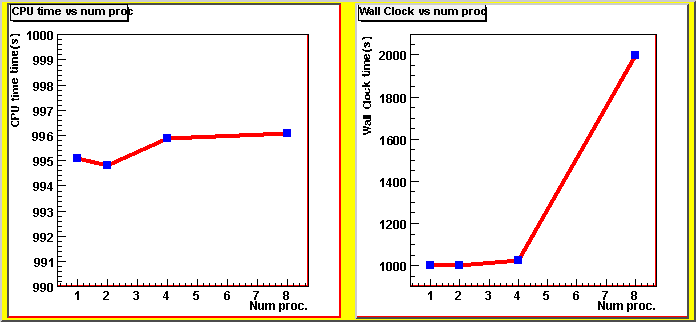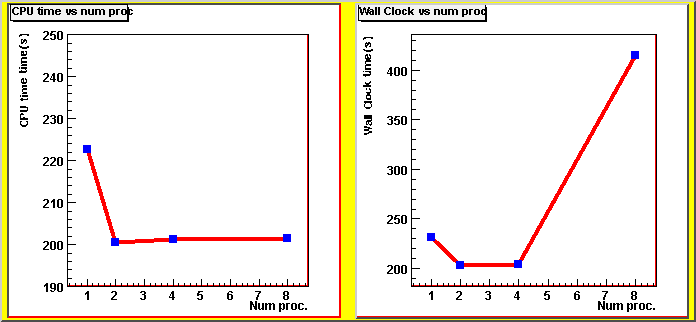
CDF Run II Offline Performance Test
Goal
We will describe the performances tests executed on a Linux machine (pcdfsrv.pd.infn.it)
dedicated for CDF Run II code development and analysis located in Padova.
The performance tests will focus on:
-
compiling and linking time of executables.
-
executing times for a typical physics analysis job.
Particular attention has been paid also to run the tests in heavy load
conditions.
Hardware and Software Description
The pcdfsrv.pd.infn.it
machine is a Linux quadripocessor Intel box.
The version of the CDF RunII offline is 3.16.0
using the shared
libraries and all the tests will be performed using NNbTag (my
own version of ExoticMods).
This module builds a job that performs the following features (i.e. a job
for a physical analysis):
Jet clustering (Cone Algorithm).
Tracking in the COT.
Tracking in Silicon (OutsideIn).
SecVtx b-tag.
Jet Probability.
Calculates some jet-related useful variables.
To load the NNbTag package do the following steps:
-
setup cdfsoft2 3.16.0
-
setenv USESHLIBS 1
-
newrel -t 3.16.0 test
-
cd test
-
addpkg ExoticMods
-
download nnbtag.tar
-
gunzip nnbtag.tar.gz
-
tar -xvf nnbtag.tar
That will generate a package whose name is ExoticMods but it will be completly
different from the one that you can upload from the CVS. The NNbTag package
will be added to the standard release as soon as I have time to do it!
So in the following steps I'll refer to ExoticMods rather than NNbTag.
It is NOT a mistake.
Test A: Compiling and Linking
We have measured:
-
the elapsed "ClockWall" time ( %E in time command of csh) for compiling
the whole ExoticMods package to generate the ExoticModslib libraries
(gmake ExoticMods.nobin).
-
the "Clock Wall" time to link and build the executable (gmake
ExoticMods.tbin).
It might be interesting to understand wether one can use the CDFII
offline under AFS to compile, link and build executables. So we have
repeated the previous tests using the CDF II offline on AFS
located in two different geographical locations: Trieste and CNAF
(Bologna). The last setup should be faster since the CNAF connection
is linked with a wider band.
For comparison the same tests has been performed on the fcdflnx1
box at FNAL. The results are summarized in the following table.
|
pcdfsrvr
local |
pcdfsrvr
AFS TS |
pcdfsrvr
AFS BO |
fcdflnx1 |
| gmake ExoticMods.nobin |
2:56
|
4:51
|
5:03
|
2:43
|
|
gmake ExoticMods.bin
|
3:01
|
51:42
|
37:42
|
2:55
|
Summary:
-
Compiling and linking time are approximately the same using fcdflnx1
or pcdfsrvr compiled with local libraries.
-
The time for linking using remote libraries is approximately ten times
more using local libraries
-
An improvement using the remote libraries can be obtained increasing the
bandwith.
Test B: Generation of events
With the standard cdfSim
executable we have measured the time to generate 50 ttbar events with IsaJet
(ttbar.tar). To check the performances
in high load conditions we have measured the performances while 1,2,4 and
8 processes were running at the same time. The results are summarized in
the pictures below.

Summary:
During the generation of ttbar events the CPU are well occupied by
the processes. In particular the "Wall Clock" time doubles when the number
of processes is twice the nuber of precessors. That means that no time
is loss shuffling around the processes.
Test C: Reconstruction of Events
On 50 z->bbbar events we have run the NNbTag job described before. Also
in this case we have checked the behaviour of the system in a heavy load
situation. Also the NNbTag job is a very complete job that performs jet
reconstruction, silicon clustering, tracking and search for secondary vertex.
As in the previous test we have run 1,2,4, and 8 process in the same time.
The results are summarized below.

Summary:
Also in this case, where more memory is used, the "Wall Clock"
seems to scale well when the number of processes is twice the number of
processor (203.75s for 4 processes against 414.56s for 8 processes).
TestD: I/O Performances
After the reconstruction is executed the CdfTrackCollection are stored
using STNtuple package. The time to write them is measured also in heavy
load condition. Also the time to read them using a root script is evaluated.
TODO
Conclusions:
TODO
Antonio Sidoti
me fecit
Last Update: 03 July 2001
 Back to the RunII Computing and Software Page
Back to the RunII Computing and Software Page


